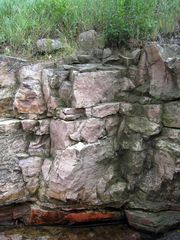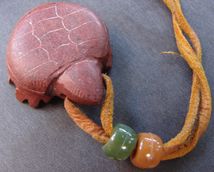
George Catlin was a painter who, between 1830 and 1836, traveled extensively between the Missouri River and the American Southwest painting scenes and portraits of American Indian life. In 1836 he visited quarries in what is now Pipestone National Monument in southwestern Minnesota, where the stone for the famous calumets (peace pipes) was quarried, and he sent a small sample to Boston for analysis. Because the stone had not formerly been scientifically identified, it was named "catlinite" in his honor. Popular usage often calls it "pipestone."
Catlinite is a reddish clay composed of silica (SiO2) and alumina (Al2O3) with much smaller amounts of several other materials. It occurs only in this one area, in a vein sandwiched between layers of very much harder Sioux quartzite.
 |
| This turtle-shaped "good luck charm" was made of catlinite and intended for the tourist trade. |
The quartzite must be carefully removed to get at the pipestone vein, which makes up a series of layers totaling about 50-60 cm thick, of which usually only a couple of inches are part of a single layer. It takes a couple of inches of thickness to make a pipe, so much of the catlinite cannot be used for that purpose, and today it is often made into tourist curios, despite its semi-sacred status in earlier times.
Soft for a stone, but hard for a clay, pipestone is worked by sawing, carving, or incising, and then by polishing. Both slabs of pipestone and finished pipes were widely traded across much of North America. Although pipes were sometimes made of other materials, it is probably safe to say that the majority of them were made of pipestone from this single quarry area, in a vast trade network, somewhat the way North Carolina mica was traded extremely widely.
Click here for More About Calumets.
